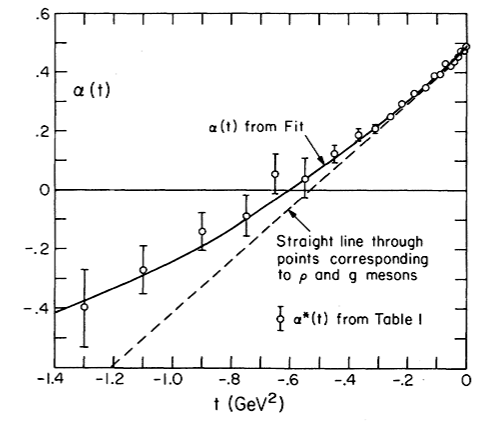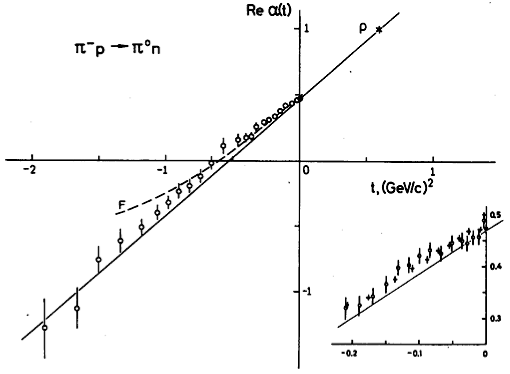Reggeons meet partons
(CNYITP seminar, '05)
Oleg Andreev & Warren Siegel
hep-th/0410131
Quantized tension: Stringy amplitudes with Regge poles and parton behavior
Energy regions for hadrons
- Low: lattice, σ, instantons, nonrel. quarks
- Spectrum (high & low): Regge
- High, small angle (“soft”): Regge (sometimes pQCD)
- High, large angle (“hard”): pQCD
Regge theory
- α(t) relates spectrum & high-E, small-θ
- Spin J = α(M2), Amplitude ∼ β(t)sα(t)
- “Small” coupling → α(t) = α’t + α0 linear
- Tree = poles → DHS (s↔t) duality (strings)
- Experiment: OK for -2 GeV2 ≤ t ≤ 6 GeV2;
α’ ≈ 1 GeV-2, α0 ≈ ½ (ρ,ω,...) - Reggeons (mesons/baryons) easier than pomerons (glueballs): spectrum known, cuts don’t get in way

Barnes et al. ‘76 (Fermilab data)

Apel et al. ‘79 (Serpukhov data)
t < 0: πN charge exchange scattering (t-channel pole)

Desgrolard et al. ‘00 (PDG,RPP data)
t > 0: spectrum (s-channel pole)
Partons in Reggeons?
- Strings → exponentials, not powers, for parton propagators (large transverse p)
- pQCD = nonperturbative strings?
- Sum cuts or “sister trajectories”?
- How to interpolate small θ ↔ large θ?
AdS/CFT: Polchinski & Strassler
- AdS/CFT: 5th dimension = running tension
- P&S: α’ = cutoff on 5th D, introduces scale
- Continuum of trajectories, slope ≤ α’
- Regge & partons, but continuous spectrum

Continuum of trajectories → continuous spectrum (t > 0)
Our proposal
- ∑ over discrete tensions (not ∫ ) → discrete, integer-spaced spectrum
- Intercepts converge → partons
- Trees: leading order for both Reggeons & partons (cf. Gribov, Dokshitzer, Hoyer)
Cuts & sisters
- Quantized tension (OK)
- Higher tension only at higher-pt. → useful only for Pomeron (total cross section)
- Intercepts don’t converge → no partons
- Cuts: αn(t) = α’t/n -bn +1
- Sisters: αn(t) = (α’t+α0)/n -½(n-1)
Picture
- Many (straight) trajectories αn(t), but highest one (“top trajectory”) dominates
- For t > 0, α1(t) = α’t+α0 dominates → usual spectrum
- For -s ≪ t < 0, same or corrections from βn(t) → still Regge (as for P-S)
- For t ≪ 0, α∞(t) = const. dominates → usual parton behavior (as for P-S)

Corrections from weights extend Regge region to t < 0
General set-up
- αn(t) has same poles as α1(t) → α’M2+α0 = an J + bn ,
an & bn integers → αn(t) = (α’t + α0 - bn)/an - an & bn increasing, bn/an→ const. (n→∞)
- A = ∑wnAn , An = string amplitude, wn ≈ (c/n)an-c , c = ½ # quarks
Simplest model
- αn(t) = α’(t-t0)/n + J0 , J0 integer
- For t ≥ t0, αtop(t) = α1(t) = α’(t-t0) +J0
- For t ≤ t0, αtop(t) = α∞(t) = J0
- With above wn, A ∼ sα1(t) also for t0 - t ≪ (c+1)/α’ln(α’s)
- Fixed θ, high E: A ∼ (α’s)2-c (also more generally)
Interpretation
- Assume αtop(t) “turns” at t0=0 (as for P-S),
so α1(t) = α’t +α0, α∞(t) = α0 - α0 ≈ ½ for Reggeon, 1 for Pomeron
- Then α∞ (large -t) represents “jet” (far off-shell hadron), with α0 = spin of parton carrying most of E (quark for Reggeon, gluon for Pomeron)
- So treat jet, not parton, as fundamental
